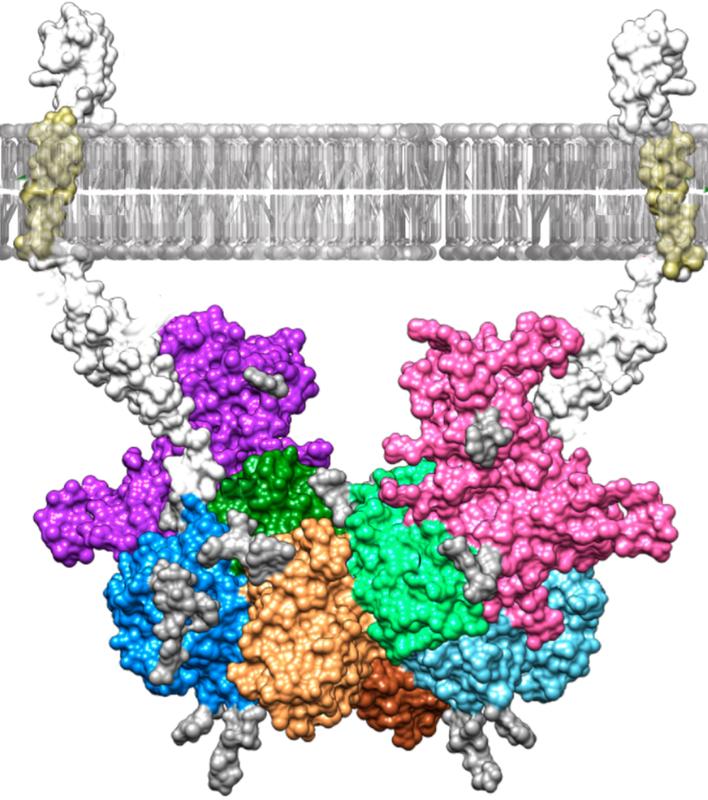Inhibition of the meprin β enzyme linked to the development of Alzheimer’s disease analyzed

Model of the molecular complex that results when the blood plasma protein fetuin-B (purple and pink) binds with the enzyme meprin β (other colors)
ill./©: Walter Stöcker
Findings of researchers at Mainz University could lead to the creation of new drugs.
Researchers at Johannes Gutenberg University Mainz (JGU) in Germany and the Institute of Molecular Biology of Barcelona in Spain have discovered how the blood plasma protein fetuin-B binds to the enzyme meprin β and used a computer model to visualize their findings. These results could lead to the development of new drugs to treat serious diseases such as Alzheimer’s and cancer. Meprin β releases proteins from cell membranes, thus controlling important physiological functions in the human body.
However, a dysregulation of this process can trigger the development of Alzheimer’s and cancer. Meprin β is regulated by fetuin-B binding to the enzyme when required, thereby preventing the release of other proteins. Presenting their findings in the journal “Proceedings of the National Academy of Sciences”, the researchers are now the first to describe this binding in detail.
The team at Mainz University produced both meprin β and fetuin-B in insect cells and then allowed them to react with one other in a test tube. By means of measurement of enzyme kinetics and biophysical analyses, the researchers determined that this reaction resulted in an exceptionally stable, high-molecular-mass complex.
Their colleagues in Barcelona subsequently managed to crystallize the complex and determine its three-dimensional structure using X-ray crystallography. This involved X-rays being fired at the protein crystals, which allowed the atomic structure of the crystals to be calculated from the diffraction of the X-rays. A computer model of the structure was then generated.
“Thanks to the model, we can now see exactly how meprin β and fetuin-B bind together,” said Professor Walter Stöcker, who conducted the research at JGU together with Dr. Hagen Körschgen and Nele von Wiegen. “This research represents an excellent starting point for gaining a better understanding of diseases such as Alzheimer’s and for developing the drugs to combat them.”
Meprin β is already known to be involved in the formation of so-called beta-amyloid plaques, which are a characteristic feature of the condition. Moreover, people with Alzheimer’s disease have relatively little fetuin-B in their blood, which in turn may lead to a lack of regulation of meprin β. “If it is possible to develop a drug that binds to the enzyme and inhibits it in a similar way to fetuin-B, this could be a new way of treating Alzheimer’s,” concluded Stöcker.
Wissenschaftliche Ansprechpartner:
Professor Dr. Walter Stöcker
Institute of Molecular Physiology (IMP)
Johannes Gutenberg University Mainz
55099 Mainz, GERMANY
phone: +49 6131 39-24273
e-mail: stoecker@uni-mainz.de
https://www.blogs.uni-mainz.de/fb10-stoecker/prof-dr-walter-stoecker/
Originalpublikation:
U. Eckhard et al., The crystal structure of a 250-kDa heterotetrameric particle explains inhibition of sheddase meprin β by endogenous fetuin-B, PNAS, 118: 14, 6 April 2021,
DOI: 10.1073/pnas.2023839118
https://doi.org/10.1073/pnas.2023839118
https://www.uni-mainz.de/
Media Contact
All latest news from the category: Life Sciences and Chemistry
Articles and reports from the Life Sciences and chemistry area deal with applied and basic research into modern biology, chemistry and human medicine.
Valuable information can be found on a range of life sciences fields including bacteriology, biochemistry, bionics, bioinformatics, biophysics, biotechnology, genetics, geobotany, human biology, marine biology, microbiology, molecular biology, cellular biology, zoology, bioinorganic chemistry, microchemistry and environmental chemistry.
Newest articles

Trotting robots reveal emergence of animal gait transitions
A four-legged robot trained with machine learning by EPFL researchers has learned to avoid falls by spontaneously switching between walking, trotting, and pronking – a milestone for roboticists as well…

Innovation promises to prevent power pole-top fires
Engineers in Australia have found a new way to make power-pole insulators resistant to fire and electrical sparking, promising to prevent dangerous pole-top fires and reduce blackouts. Pole-top fires pose…

Possible alternative to antibiotics produced by bacteria
Antibacterial substance from staphylococci discovered with new mechanism of action against natural competitors. Many bacteria produce substances to gain an advantage over competitors in their highly competitive natural environment. Researchers…





















